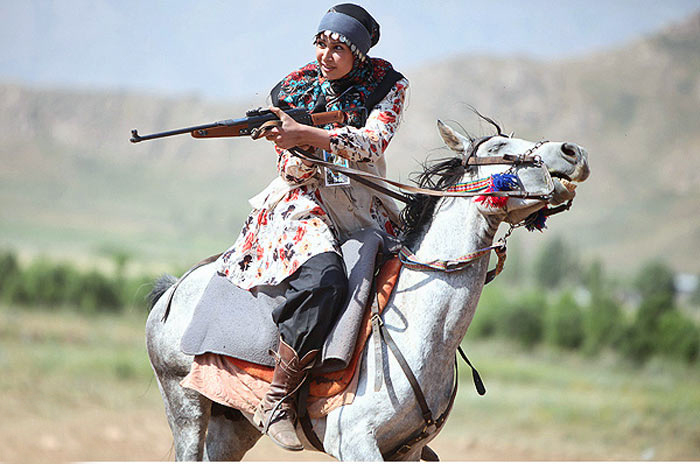Chuqa, the famous clothing of Bakhtiari men in Chahramahal and Bakhtiari Province, which enjoys a 150 year-old history, has been inscribed on the national heritage list.
The noble, original outfit of local men with exquisite patterns and unique well known model, it is considered one of the major handicrafts of the province’s nomadic tribes, said the handicrafts and traditional arts deputy of the provincial Iran’s Cultural Heritage, Handicrafts, and Tourism Organization (ICHHTO), Mehrdad Raeesi.
With Chuqa being added to the list, the total number of inscribed handicrafts of Chaharmahal and Bakhtirai Province reached 11; among them a salt shaker, locking tong, scissors, knife, felt, Lachak (a type of headgear/headwear), lock, Giveh (traditional footwear), and Veris (a hand-woven rope with various uses).
Bakhtiari Clothing
The Bakhtiaris reside in mountainous regions of southwest Iran, including the provinces of Khuzestan and Esfahan. Although they are known to be a mostly nomadic people, many of the Bakhtiaris have now settled in villages and towns.
All members of the Lori-speaking ethnic groups, which include the Lors themselves, the Bakhtiaries, and the Boyer-Ahmadis are characterized by a similar style of dress, with variations reflecting differences in tribe and social class. The variations can have strong symbolic meaning, particularly among the Bakhtiaris. There have been significant changes in the basic male dress over this century, as compared to those observed by travelers in the 19th and early 20th centuries.
Bakhtiari clothes are said to be so versatile, while providing protection from extreme weather.
Men
The tribesmen wear a costume composed of the same basic elements: a felt cap (kolah), a shirt and vest, long trousers of varying degrees of fullness, and sandals (giveh). Nowadays a small cap (sometimes called shaw-kola) of beige, brown, or black felt is the most common head covering. Among the Bakhtiaris, however, it is worn only by boys and shepherds; mature men and chiefs prefer the kolah-kosrawi, which is taller, almost cylindrical in form, and black (though formerly sometimes white among the ranking chiefs, khavanin-e bozorg). Particularly characteristic of Lori male costume is the chuqa, a straight, knee-length, sleeveless tunic of natural white wool with vertical indigo stripes.
Today, the tunic is often worn over a western jacket (kot). The Chuqa was probably once found only in Luristan and must have spread among the Bakhtiaris in the 1940s, replacing the qaba (cloak). It is possible that Bakhtiari men gave up the qaba more willingly than some of their other garments because it was commonly worn throughout the country and did not constitute a distinctive part of their traditional costume. The finest Chuqas are called chuqa-livasi, after a village in Lurestan celebrated for making them.
The trousers constitute the most distinctive part of Bakhtiari male dress, however, serving as a badge of tribal identification. These trousers are black and cut very wide (120 cm around the leg). They are also called shalwlar-e Dabit as they are tailored from a material known as Dabit. The best kind of Dabit materials are Dabit Haj Ali Akbari and are famous for their permanent color and softness.
The trousers are held up by a leather belt which they fasten around their ankles with broad embroidered bands, or if worn by Chuqa, with a large sash of rolled white cloth (shal), in the folds of which it is customary to carry useful objects like a pipe and a knife. The sandals are of the giveh-maleki type, with pointed leather toes that curve upward. Beside these basic elements several additional garments are worn for specific purposes, for example, the felt capes and mantles of the shepherds.
Women
Costumes of women of the Zagros have varied less over time than that of the men.
It consists of a headdress; a knee-length dress slit on the sides, with long sleeves (pirhan, jumeh, or joveh); and a long, colorful, several-layered full skirt (as much as 8-10 m around the hem) gathered at the waist.
The skirts are then paired with separate shirts and matching vests or shawls. Long scarves and wraps for the head are also commonly worn with ornaments (e.g. faux coins) or hand-stitched designs sewn in.
Bakhtiari women wear a hood (lachak) to which a veil (mayna or meyna) is pinned in such a way as to frame the face without hiding it. Meyna is a long chiffon scarf in various bright colors such as blue, green, yellow, magenta, and purple.
In winter a velvet caftan (balkaal) completes the outfit. Female garments are usually in very bright colors, except during periods of mourning. There is hardly any difference in dress between social classes, except in the quality of fabrics and the richness of ornament (e.g., glass beads and coins).
Bakhtiari women also used to wear giveh in the past, but nowadays they wear shiny black leather shoes which are called Orssi in the local dialect. The cheaper rubber versions of the shoes are also used by some, named gaalesh.


